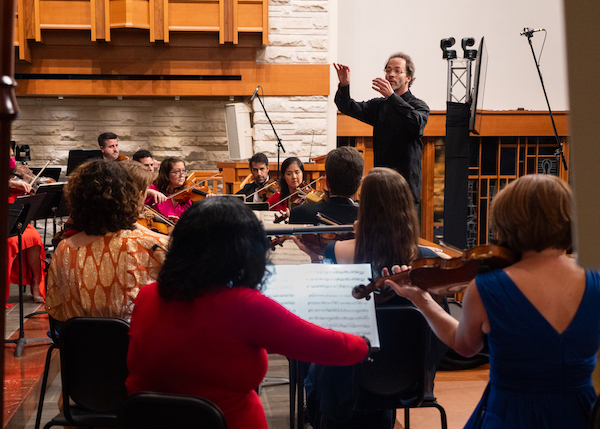
By Steven Brown
Photo: Violeta Alvarez
Johannes Debus conducted the ROCO Chamber Orchestra Saturday at the Church of St. John the Divine in Houston.
Source: ROCO energetically serves up a host of rarities and two world premieres
Nearly everything Houston’s ROCO chamber orchestra played Saturday under guest conductor Johannes Debus must have been new to the group’s audience. The two world premieres obviously qualified, and the bill of fare included another work that dates back just a few years. When was the last time you heard an orchestra play Mendelssohn’s Symphony No. 1?
The program’s extra-musical associations ranged from Dante’s Divine Comedy to Golden Age Hollywood to celestial orbs—and ROCO dispatched the entire program with zest Saturday at the Church of St. John the Divine.
Brazilian-American composer Clarice Assad declares herself “a vast Carmen Miranda fan” in her program note for Ode to Carmen Miranda, the concert’s opener and the first of the premieres.
For those not attuned to movies of the 1940s, the Brazilian singer-dancer “was exoticized and typecast in outrageous musicals as the very stereotype of the ‘Latin spitfire,’” as Assad’s note puts it. Her fruit-topped headgear in itself became a symbol of Hollywood fantasy and flashiness. But Miranda, “trapped by her Hollywood image,” eventually lapsed into depression and died at only 46—“a tragic end for a star who had glowed so brightly.”
Assad’s five-minute tribute puts the exuberance of Miranda’s Hollywood persona in the forefront. After a short percussion fanfare, the woodwinds charge into the first of the work’s jazzy, vivacious themes, with the rest of the orchestra adding Latin-tinged rhythms as further propulsion. A rousing clarinet solo and a drum-set outburst are among the free-spirited turns that follow. A yearning passage launched by a clarinet points toward Miranda’s inner unhappiness, but the music’s party soon resumes.
Led by guest conductor Johannes Debus, the Canadian Opera Company’s music director, ROCO threw itself into the music’s vigor and abandon. In its rowdiest moments, Assad’s piece has too much going on and her scoring could use some revising prevent brass and percussion from drowning out the score’s vivacious themes.
Richard Danielpour’s Triptych (Symphony in Three Movements) reveals where it’s coming from with its subtitle: “After the Divine Comedy of Dante Alighieri.” Danielpour’s program note hails the “inherent message of love and compassion” in Dante’s epic, then goes further. The journey from hell through purgatory to paradise serves as a metaphor for the period when “the world was consumed with, and in some cases by, the COVID-19 pandemic,” Danielpour says. “The music is a reflection on those years: the suffering, the patience, the endurance, and finally the emergence from that dark place that many of us experienced.”
ROCO is splitting up that journey through the season and on Saturday offered only the first movement, “Nell’ Inferno”; the two remaining movements will be performed in February and April.
“Nell’ Inferno” begins in gloom, conjured up mainly by the darkness of the low strings. The clarinet spins out a plaintive melody, and the strings soon take it up. Pounding chords soon interrupt the brooding. The tempo accelerates, and the rest of the movement is a staccato surge of sharp-edged lines—some of them transformed from that opening melody—flashing sonorities and driving rhythms.
Obviously, it was impossible Saturday to gauge how the dynamic, 10-minute piece fits into the rest of Danielpour’s Triptych. But even if this were absolute music labeled something like Introduction and Toccata, it would still be a compelling picture of unease and agitation.
Debus and ROCO brought depth of sound and breadth of lyricism to the forlorn opening. And when tumult took over, the players tackled it with dynamism, incisiveness and impact galore.
There could hardly have been a bigger contrast than that between Danielpour’s visceral score and Missy Mazzoli’s ethereal Sinfonia (for Orbiting Spheres).
The title alludes not only to the image of a solar system but to the medieval hurdy-gurdy—once called sinfonia in Italian—which was a string instrument that in part produced long, sustained notes.
In a nod to the hurdy-gurdy’s drones, Mazzoli’s nine-minute piece unfolds against a background of quiet strings’ hovering and shimmering. Interjections from the rest of the orchestra appear and disappear like planets through the heavens. One moment, the winds add a bit of liveliness; another, the brasses intone a few hushed but stately phrases.
It all adds up to a compelling tone-painting, and ROCO filled it with gleam and transparency. Amid the stillness here as well as the bustle of Assad and Danielpour, Debus guided the group with directness and crispness.
For all the sonic spectacle ROCO produced for Assad and Danielpour, it probably put the most sheer virtuosity into Mendelssohn’s fiery Symphony No. 1—written when the composer was 15.
In the tempestuous first movement and finale, the orchestra—especially the strings—charged ahead with agility and eagerness. Yet, led by Debus, the group also switched instantly to lightness and finesse when Mendelssohn’s flights of melody called for it.
The slow movement sang out mellifluously. In the Menuet, the orchestra’s robustness gave way to the middle section’s spotlight on euphonious winds.
The strings also brought their virtuosity to bear on the program’s one familiar work: Mozart’s Divertimento in D major, K. 136.
Debus put down his baton, and he sometimes skipped time-beating to indicate simply the character and buoyancy he wanted. The players responded with alacrity, filling Mozart’s delectable score with elegance, buoyancy and dash. The Andante flowed along so smoothly that Mozart’s lyricism gained the lilt of a dance.

Leave A Reply